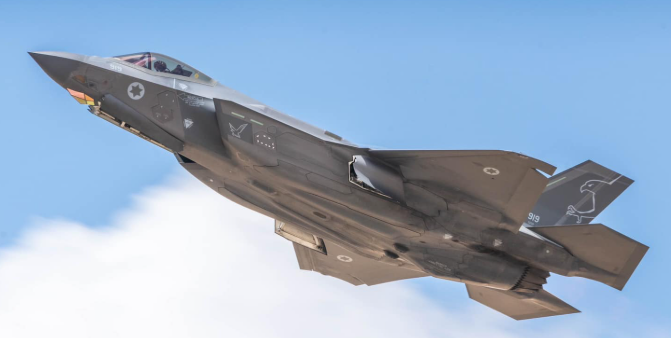ARTICLES
Follow Us
Be the first to know
F-35s Compared: How Israel's AI-Enhanced Fleet Outpaces the U.S. Standard
By:
Arman M Nazari
President,
Global Technical Resources | Aerospace & Defense SME
Introduction: The Global Edge of 5th Gen Airpower
The F-35 Lightning II is widely regarded as the most advanced multirole stealth fighter ever built. Designed by Lockheed Martin for the United States and allied nations, the aircraft's stealth, situational awareness, and integrated sensor suite represent a leap in air superiority. However, not all F-35s are created equal. Nowhere is this more evident than in the comparison between the United States Air Force’s standard-configured F-35As and the Israeli-modified F-35I “Adir.”
The American F-35, Standardization and Strategic Control
The U.S. F-35A is designed for interoperability, with a centralized upgrade process, standardized software, and strictly controlled source code. It is fielded in large numbers, forming the backbone of America’s future tactical air fleet.
- Advantages:
- Full-spectrum stealth
- Standardized training, maintenance, and logistics
- Interoperability with NATO allies
- Cybersecurity safeguards via software compartmentalization
- Limitations:
- No access to core source code by partners
- Centralized upgrades mean slower adaptation to specific regional threats
- AI and data fusion controlled by U.S. military protocols
The Israeli F-35I “Adir”, A Customized, AI-Enhanced War Machine
Israel remains the only country with full access to the F-35’s source code, enabling unprecedented customization. The
F-35I "Adir" is more than just a variant — it’s a sovereign platform tailored to the unique threats of the Middle East.
- Key Enhancements:
- Full AI and data fusion integration with Israeli defense networks
- Locally designed Electronic Warfare (EW) systems and mission computers
- Real-time battlefield learning capabilities using Israeli-made AI models
- Custom weapons loadouts, including indigenous smart bombs and electronic decoys
- Operational Independence:
Israel can rapidly update its F-35I fleet without U.S. approval, making it uniquely adaptable in fluid combat environments.
Hardware Modifications, Built for Israel’s Warzone
Beyond the software, the Adir incorporates
significant hardware enhancements to match the IDF’s extended operational requirements:
- Conformal Fuel Tanks (CFTs):
Designed to blend into the fuselage and preserve stealth, these tanks dramatically extend range ,critical for deep missions into the Islamic
Republic in Irahn (spelled with an “h” here to reflect proper pronunciation: “Ee-rah-hn”).
- External Stealth-Compatible Hardpoints:
Israel is developing external pylons that allow F-35Is to carry extra munitions with minimal radar penalty, enhancing payload versatility.
- Custom Electronic Warfare Suite:
The F-35I integrates Elbit Systems EW gear, jamming pods, and threat classification systems unique to the Israeli variant.
- Open Avionics Architecture:
This enables real-time connection to IDF battlefield networks, indigenous munitions (e.g., SPICE, Rampage), and sovereign mission computers.
- Independent Maintenance and Logistics:
Unlike other partners, Israel does not rely on the U.S.-controlled ALIS/ODIN systems, it performs all diagnostics, upgrades, and repairs
independently.
These changes transform the Adir into a flexible, high-endurance, sovereign strike platform far beyond its baseline F-35A cousin.
Combat-Tested, F-35I in Irahn and Yemen Operations
The Adir is not just theory, it’s been blooded in major long-range precision campaigns. Note that throughout this article, we spell “Irahn” with an H to emphasize its correct pronunciation (Ee-rah-hn) and distinguish it from common Western mispronunciations.
Against the Islamic Republic in Irahn:
- Operation Days of Repentance (October 2024):
Israeli F-35Is struck the Islamic Republic’s missile production facilities and air defense networks. The operation neutralized key
infrastructure, reportedly laying the groundwork for future actions against nuclear and oil assets.
- Operation Rising Lion (June 2025):
A full-spectrum strike on nuclear facilities and command nodes. Reports indicate F-35Is executed simultaneous decapitation and
sabotage missions, some assisted by autonomous onboard AI.
Against Yemen:
- Operation Outstretched Arm (July 2024):
Conducted in response to Houthi attacks on Israeli territory. The Adir showcased long-range strike capacity deep into hostile airspace.
- Operation Black Flag (July 2025):
Systematic targeting of Houthi-controlled port infrastructure used for Iranian proxy support, showing the Adir’s endurance and maritime
interdiction role.
- Operation Golden Jewel:
Earlier airstrike disabling the Sanaa airport, cutting off critical Houthi logistical channels.
These operations demonstrated the Adir’s ability to penetrate layered defenses, adapt mid-mission via onboard AI, and deliver effects with minimal collateral damage.
Geopolitical Implications, Sovereignty vs. Standardization
- The U.S. F-35 model emphasizes alliance cohesion, shared doctrine, and cybersecurity via tightly controlled logistics and software.
- The Israeli model prioritizes operational sovereignty, rapid adaptation, and independence in intelligence, maintenance, and strike authority.
This divergence reflects differing threat environments: NATO's focus on peer deterrence vs. Israel’s need for immediate unilateral action.
Looking Ahead, Israel as a Preview of the 6th Generation
The Israeli F-35I “Adir” may preview what future 6th generation fighters will look like:
- AI-native architecture
- Customizable software and hardware
- Sovereign control over upgrades and logistics
- Real-time operational autonomy
While the U.S. maintains scale and reach, Israel may have built the most adaptable, self-reliant stealth strike platform in the world today.
Conclusion: A Tale of Two F-35s
The U.S. and Israeli F-35s represent two distinct philosophies of airpower:
- Standardized strength focused on alliance-wide consistency
- Adaptive sovereignty focused on national flexibility and AI-driven autonomy
In the age of precision warfare and emerging threats, the Israeli Adir sets a benchmark in future-proofing combat aviation, by blending stealth, AI, and national control into a single lethal platform.











